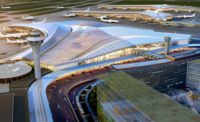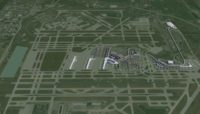The $8.5-billion revamp of O'Hare International Airport may have to be delayed because of COVID-19 related economic impacts, according to documents included in paperwork to refinance existing airport debt. The city forcefully disagreed with that summation, however, and says the project will move forward and is not endangered.
The ongoing renovations are expected to be completed by 2028. The revamp, dubbed O'Hare 21, is centered on a new global terminal designed by Studio Gang Architects, part of the Terminal Area Plan [TAP], but also includes gate expansions at existing terminals 3 and 5, airport cargo and hotel development, runway improvements, a modernized transit system for the airport, a multimodal facility and various associated projects.
Documents the city filed as part of a pending deal to refinance $1.24 billion in existing O’Hare debt state that officials now are “assessing timing” on the TAP, and the 2028 completion date is "subject to change."
An analysis by consultant Ricondo & Associates is included in the documents and states the number of passengers boarding aircraft at O’Hare—known as enplanements—is expected to drop 62.1% this year because of COVID-19 fears. Ricondo projects 2021 enplanements will be only two-thirds of pre-pandemic levels, and will not top the 2019 level of 42.2 million until 2024, endangering airline revenue, a key funding source for the airport, which former Mayor Rahm Emanuel touted as the reason the project wouldn't cost taxpayers anything. United, American, Spirit and Delta airlines all pledged to pay back city debt through gate fees when the project was announced.
According to Ricondo & Associates' analysis, the compound annual growth rate of enplanements at O’Hare between 2019 and 2029 is projected at just 0.4%, and it may end up being worse. That’s well below the 2% to 3% annual growth the city counted on when it drafted the terminal improvement plan.
Current Mayor Lori Lightfoot and the Chicago Department of Aviation (CDA) pushed back on any suggestion that the TAP would be delayed in a strongly-worded statement.
"O'Hare 21 is moving forward, period, full stop. Any doubt about the City's commitment to continuing to invest in O'Hare's modernization and competitive position should be put to rest by the fact that we're currently progressing with construction on three runways (9 Center, 9 Right extension, and 4 R overlay) and a $1-billion expansion of Terminal 5," said Matt McGrath, spokesman for the CDA, in a statement.
TAP phase 1 is in the early design and environmental approval stage, which provides it the flexibility to stay on course and not make sudden decisions. "It has provided us some flexibility to move forward in a more efficient and economical way, as well as to assess longer-term impacts of the pandemic on traveler expectations," the statement said.
The CDA said it expects the industry to fully recover, and its airports — O'Hare and Midway — to be at the forefront of the recovery.
"To trim our sails on O'Hare 21 right now would be both rash and short-sighted, not to mention largely inconsequential to current airport costs," McGrath's statement said. "In fact, during the COVID-19 disruption, our hub carriers have been using every gate available to them multiple times per day to maximize connectivity in their schedules, which indicates the importance of scale in how the airlines generate revenues in the hub-and-spoke business model."
The CDA is working closely with its airline and airport partners to find near-term operations and maintenance savings and has so far identified $65 million in savings at O'Hare, the statement said.
McGrath said the 15-Year O’Hare Capital Improvement Plan, to which the Ricondo & Associates analysis was attached, is "a specific classification and source of funding of projects, not an umbrella term for airport construction projects to include ORD 21/TAP. It's more often things like taxiway/apron repairs, roof repairs, etc.— and actually the 4R overlay. But if we say we're seeking savings or slowing down CIP spend, it's not really referring to TAP."
O’Hare’s long-term debt ratings by agencies Standard and Poor’s, Fitch and Kroll remain strong. O’Hare is the only airport of the six largest in the nation to have its rating affirmed by all three agencies. Moody's Investor Service does not rate the Chicago airport bonds nearly as high.
In early September, S&P Global Ratings said of its rating: "We base our positive adjustment on ORD’s position as the nation's third-largest airport based on domestic and international enplanements, its significant role in the U.S. domestic aviation network and status as a key international gateway. Other considerations include ORD's favorable geographical orientation, significant size and scope, large and economically favorable O&D market, strategic importance to United Airlines and American Airlines Inc. and actions taken by management to mitigate the financial effects from the sudden drop in air-travel demand."






Post a comment to this article
Report Abusive Comment